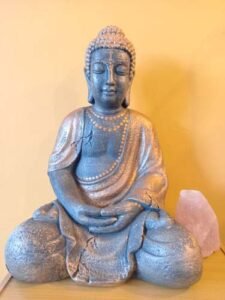Placing a statue of Buddha in your home or garden is a great way to promote positive energy, or chi, in your environment.
Gautama Buddha, the founder of Buddhism and the harbinger of Buddhist teachings, is the inspiration for the many Buddha statues available for purchase today.
 The popularity of Buddha as a symbol of peacefulness has made the Buddha a rather secular and versatile symbol which many people display for decor purposes.
The popularity of Buddha as a symbol of peacefulness has made the Buddha a rather secular and versatile symbol which many people display for decor purposes.
However, to honour the meaning and history that the Buddha represents, there are traditional and auspicious rules around placing a Buddha that we should understand.
The position of the Buddha and specifically the hand gestures (mudras) determine how and where the statue should be placed. As a general guideline your Buddha statue should always be above eye level as it is disrespectful to look down at it, and you should also avoid placing it in any unsanitary parts of the home, such as the bathroom or kitchen, and avoid placing it in the bedroom.
These are some common depictions of the Buddha.
Bhurmisparsha Buddha, Earth Touching Buddha – The Earth Buddha sits with his right hand facing inward and pointing to the Earth beneath him and his left hand in meditation.
This statue refers to the time where the demon Mara repeatedly tried to tempt the Buddha, but the Buddha resisted and finally reached enlightenment. This mudra represents eternal knowledge and should be placed facing east. It is also grounding and supportive and can therefore be placed in any room of the home.
 Dhyana Buddha, Meditating Buddha – This Buddha sits with his hands folded in his lap (left under right), legs crossed, and head raised. His eyes are fully or partially closed in meditation. This Buddha can be placed in any quiet place in your home, preferably facing east, and ideally where you can sit and meditate or reflect too, and perhaps light incense and candles in this area.
Dhyana Buddha, Meditating Buddha – This Buddha sits with his hands folded in his lap (left under right), legs crossed, and head raised. His eyes are fully or partially closed in meditation. This Buddha can be placed in any quiet place in your home, preferably facing east, and ideally where you can sit and meditate or reflect too, and perhaps light incense and candles in this area.
Blessing or Protection Buddha – His right hand is raised and facing outwards as a protective shield, the other usually sits in his lap. This Buddha has two meanings – the first is to protect, and the second is to overcome fear. This Buddha should be placed at the front door of your house facing the doorway.
Nirvana Buddha, Reclining Buddha – This Buddha depicts the last moments of Gautama Buddha’s mortal life before entering Nirvana. This Buddha encourages you to seek inner harmony and peace. It is also symbolic of a transition period. This Buddha must always face west and should recline to the right.
Praying Buddha – This Buddha statue has his hands folded in prayer and is usually seated cross- legged or in lotus pose. Representing devotion and faith, this Buddha should be placed in a quiet area
of the home where ideally you can light a candle or incense and meditate in the Buddha’s presence.
– Ronja Skandera




